The flexible energy throughput of large capacity energy storage systems can be used as a new type of frequency regulation and voltage regulation method, especially for large capacity energy storage with stable output and fast response. Its frequency regulation performance and grid connection technology have become current research hotspots. In the application of battery energy storage technology, adopting appropriate control methods can improve the frequency modulation performance of battery energy storage systems and reduce the capacity requirements of the system.
1. Battery energy storage power station model and its active support control strategy
1.1 Overall Structure Model
By connecting multiple lead-acid battery modules in series and then connecting them in parallel, an efficient battery energy storage power station can be constructed. The control architecture of the power station consists of a battery pack, energy storage power supply, battery charging, and power transmission, using an active support control system with a third-order model. Figure 1 shows the complete control system of a battery storage power station.
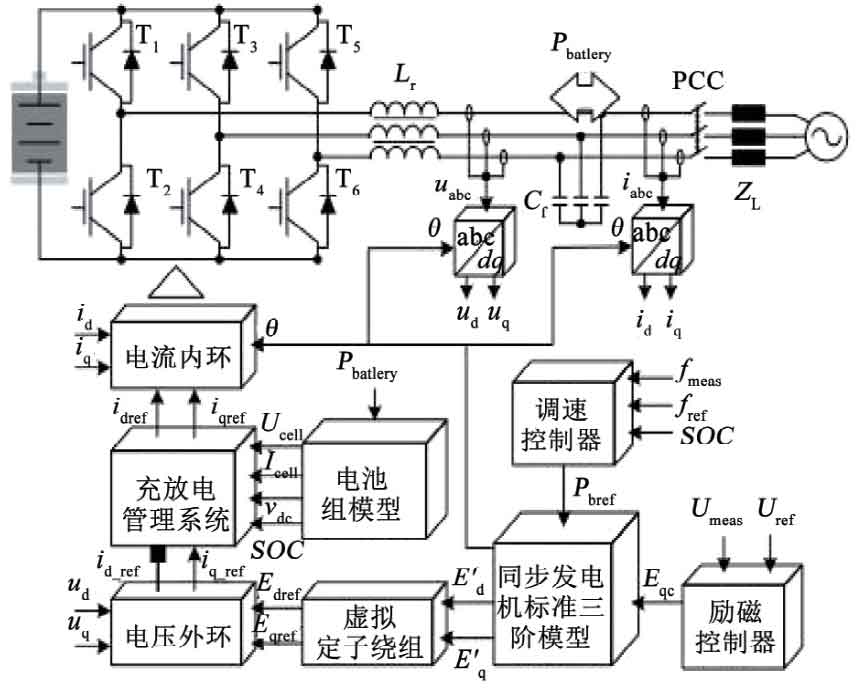
1.2 Battery pack model
In battery energy storage power stations, lead-acid battery components are the main energy source, and the short-term discharge model of the battery is:

In the formula, UB represents the final voltage of the battery pack; Eb represents the open circuit voltage of the battery; Ib represents the discharge current of the battery; Rp is the polarization resistance; R0 is a resistor used to limit the discharge voltage; τ 0 is the time constant of a double layer effect. When the battery is in a charged state, the rated capacity of each battery module is Qn, and the percentage of the state of charge (SOC) of the battery pack at a discharge current of i (t) ξ SOC can change, affecting battery performance and lifespan.

In the formula, NS and NP are the number of batteries in series and parallel in the battery pack, respectively.
Starting from ξ When SOC=0, the midpoint and endpoint of the maximum and minimum voltage of the battery pack are ξ Fit a battery pack at the maximum voltage when SOC=100% ξ The characteristic line between SOC and open circuit voltage Eb is shown in the formula:

In the formula, Umax and Umin represent the maximum and minimum open circuit voltage of the battery pack, respectively.
1.3 Active Support Control Based on Synchronous Machine Standard Third Order Model
On the basis of the third-order model of the synchronous machine, the active support control method was adopted to achieve the simulation of the external characteristics of the synchronous generator, making the excitation, speed regulation and other time scales of the energy storage station consistent with the adaptive adjustment process of conventional units. Compared with the traditional phase-locked loop control method, the active support control method can make the power angle adjustment of the energy storage converter no longer rely on the torque of the power grid, thereby improving the grid independence and anti-interference ability of the energy storage station. Among them, the active support control strategy includes excitation controller, speed controller, third-order synchronous generator, virtual sub winding, voltage outer loop, current inner loop, etc.
2. Flexibility analysis of battery energy storage power stations considering power grid frequency regulation requirements
2.1 Multi time scale frequency modulation process in power systems
The structure of the power system is complex, including multiple links such as generation, transmission, transformation, and utilization, with two major characteristics: temporal and spatial. The frequency regulation and voltage regulation of power systems are a constantly expanding time scale, and their spatial distribution exhibits complex network characteristics. The process of frequency self adjustment in the power system is an extremely complex dynamic network problem, which can be analyzed, adjusted, and described in the following aspects: time scale mainly refers to time scales such as seconds, minutes, hours, or days, with several years or more as the time scale and the long-term planning of the power system as the center.
The time period of several weeks or months mainly considers the seasonal changes of the unit, especially for hydroelectric units, which have significant seasonal load fluctuations and have obvious high and low water periods. We also need to consider situations where wind power and photovoltaic power generation are strongly affected by the natural environment. The time range in hours or days, with the phase adjustment of the power system as the main content; The minute level time scale refers to the primary frequency modulation, secondary frequency modulation, and inertial frequency modulation in the power system, which are mainly based on the allocation of the power market and the demand of the power grid; In the microsecond time range, it mainly includes the inlet and outlet of various power electronic switching devices, small changes in frequency and voltage, and instantaneous changes in inertia moment. With the interconnection and integration development of the power grid, the spatial scope of the power grid has become more complex, especially the interconnection between provincial power grids and large-scale interconnection, making the network structure more complex and the length of transmission lines continuously increasing. Due to the significant difference in frequency modulation capabilities between provincial and regional power grids, frequency modulation methods can be divided into two types: full network frequency modulation and regional frequency modulation.
2.2 Analysis of Frequency Modulation Flexibility of Battery Energy Storage Power Stations
FM must fully consider the system’s self-regulation ability and provide the best FM services at different time scales. Compared to other frequency modulation technologies, energy storage power plants have significant advantages, such as simple installation, unaffected by natural environment, fast climbing speed, flexible energy absorption and release, and superior regulation performance. Among them, the PCS energy storage converter has advanced active control technology, and its output characteristics can reach the same level as synchronous machines, making the energy buffer the best solution in extreme frequency environments. After multiple time scale frequency modulation studies, it has been found that battery energy storage stations must have high flexibility when participating in grid frequency adjustment. To achieve this goal, it is necessary to start from three aspects: 1) ensure the continuous supply of energy (MWh), and ensure the voltage and frequency regulation capabilities of the power station. 2) Change the power output speed and angle (MW/min) to affect system performance. 3) Has a great power output capacity (MW). In order to achieve flexible operation, the output of battery storage power stations can be adjusted within a certain range to support larger and higher voltage level power grids and provide auxiliary frequency modulation services.
In large-scale battery energy storage systems, it can play an important role in frequency regulation of the power grid. This flexibility can be measured by three key indicators: 1) The rated power of energy storage stations represents their performance, that is, their output power reaches the limit, thus meeting the various functional requirements of the energy storage system. 2) The climbing speed is crucial for the operation of energy storage power plants, as it can detect changes in the power grid in a timely manner and make corresponding adjustments, especially during the inertial response and primary frequency regulation stages, to ensure the stability of the energy storage system. 3) The rated power of energy storage power stations is crucial to ensure that they can meet the requirements of secondary frequency regulation. It can effectively reflect the performance of the power station and the duration of the power station’s participation in grid frequency regulation, enabling the grid to effectively utilize the energy of energy storage power stations and achieve a more stable distribution of energy resources.
3. Method for analyzing the participation and contribution of battery energy storage power stations in grid frequency regulation
3.1 Analysis of Inertial Response and Primary Frequency Modulation Characteristics of Battery Energy Storage Power Stations Participating in the Power Grid
In the power system, energy storage stations play a significant role in achieving dynamic regulation of the system through two stages: inertial response and primary regulation. The static frequency characteristics of energy storage power plants have obvious characteristics, which are very similar to synchronous generators. In order to enable ordinary units to obtain sufficient frequency modulation input, a series of measures can be taken, such as changing the adjustment coefficient of each power generation unit, increasing the kinetic energy of the rotating rotor, reducing the frequency fluctuations of the system, and effectively reducing the oscillation amplitude of the system after a frequency modulation. Energy storage technology utilizes inertial feedback technology to reduce the initial frequency of the system, combining the inertia of the actual rotating unit with the inertia of the virtual energy storage station to achieve a new control method.
When the battery energy storage station is established and can operate stably, real-time monitoring of fmeas and SOC can be achieved. When the frequency of the power grid fluctuates violently, the system will first detect SOC to determine whether it is within the frequency modulation working range (SOCmin, SOCmax). If it is within a reasonable range, it can operate normally. If it exceeds the normal range, the charging and discharging management system will be locked and no external interference is allowed. In order to ensure the safe operation of energy storage power plants, it is necessary to ensure that the frequency is within an acceptable range during fmeas testing. If the fmeas does not meet the requirements of (fref2, fref1), the dynamic frequency characteristics of the synchronous engine and its related system loads can be utilized for primary frequency regulation to ensure the safe operation and reliability of the energy storage plant. When determining that the fmeas exceeds the normal frequency regulation range, the static frequency characteristics of the energy storage station will share the frequency regulation output with the synchronous engine, that is, the energy storage will participate in the primary frequency regulation process of the power grid. The static frequency characteristics of the energy storage station are shown in Figure 2, and the expression is as follows:

When the frequency of the power system exceeds the upper and lower limits of fref1 and fref1, the charging power of the energy storage station will change, that is, the unit adjustment capacity Kbattery minus the frequency deviation, so that the power system can obtain more energy from it. As the frequency of the power grid continues to decrease, when it is below the lowest point of frequency modulation, the discharge power of the energy storage station will reach Kbattery due to the influence of frequency deviation, and the energy storage station will output a large amount of energy to the power grid.
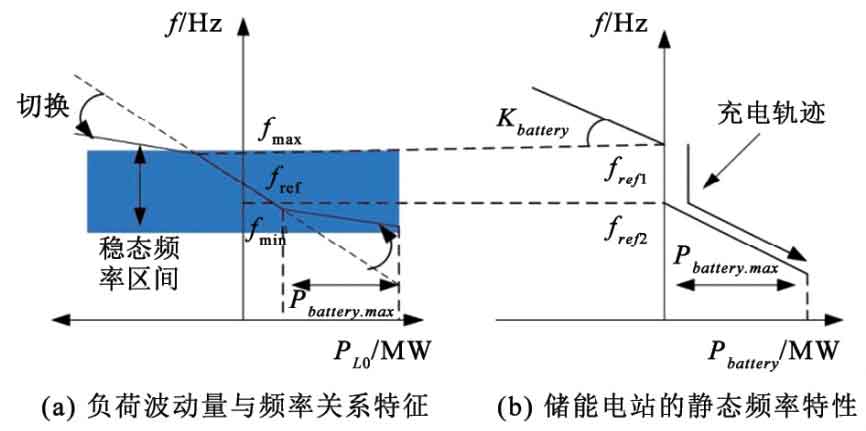
From Figure 2, it can be seen that there is a close correlation between frequency and overall load changes when using battery energy storage technology. The use of energy storage technology can automatically adjust Kbattery with changes in load and frequency, thereby improving the efficiency of the power grid. The slope of Kbattery can be adjusted to adapt to different load conditions to improve the stability of the power grid.
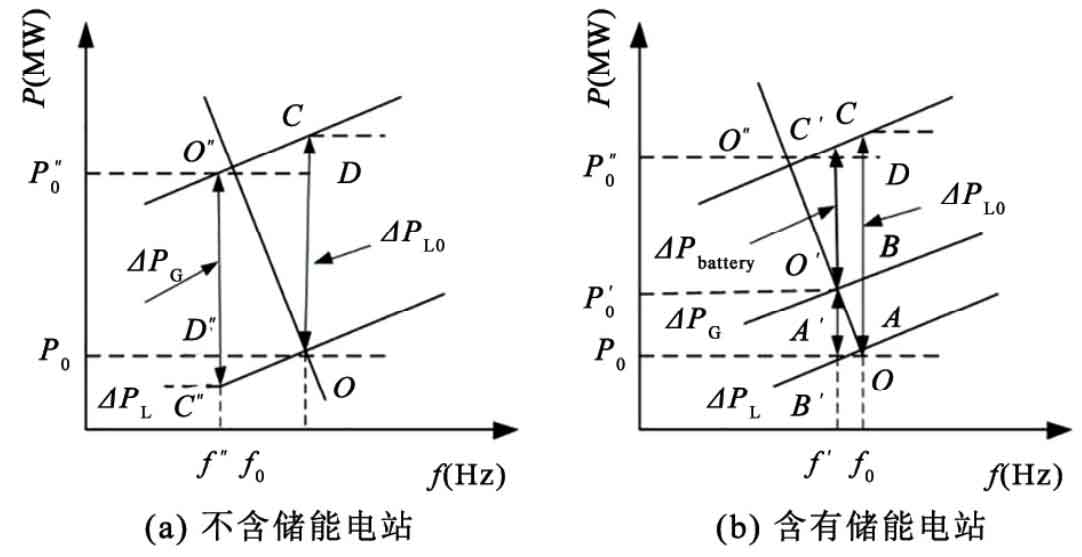
From Figure 3, it can be seen that when primary frequency regulation is applied, the operating state of conventional units will be affected, starting from the initial operating point O. As the power of the synchronous generator unit increases and the load self-regulates, the operating state gradually changes, decreasing from f0 and eventually returning to f ″ 0. Generally speaking, the supply and demand balance of primary frequency modulation is as follows:

In the formula, KG represents the unit regulated power of the synchronous generator, and KL represents the unit regulated power of the load.
Through the analysis of the positive static frequency characteristics of the energy storage system, it can be concluded that,
When the energy storage station performs primary frequency regulation, its shared power Δ Pbattery mainly depends on the frequency deviation of the system and the adjustment factor of the energy storage plant. Due to the strong coupling between the rotor speed of the synchronous generator and the output electromagnetic field, the frequency modulation output of the energy storage power station and its power allocation amount Δ There is a certain inverse ratio between PGs. When the fluctuation of synchronous generator rotor speed is small, its frequency deviation after primary frequency regulation will decrease, making the role of energy storage stations in primary frequency regulation more obvious.
3.2 Analysis of the contribution of battery energy storage power stations to the primary frequency regulation of the power grid
The ratio of the total frequency modulation power output value of the energy storage system to the total frequency modulation power output value of the rotating unit is defined as the contribution factor of the battery energy storage station to the conventional unit when participating in the primary frequency regulation of the power grid λ, The contribution factor expression is as follows:
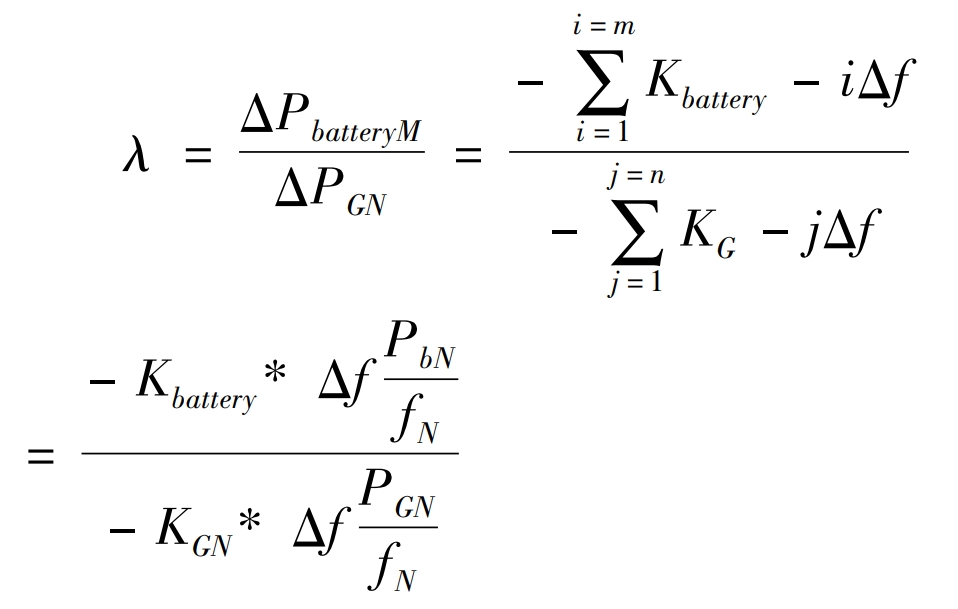
Contribution factor λ It refers to the contribution of the frequency modulation output of the battery energy storage station to the conventional unit, usually expressed as Δ As a reference, when the contribution of the energy storage station to the frequency modulation output is low, the contribution of the energy storage station to the frequency modulation output is high, while the frequency modulation power that conventional units need to share in the frequency modulation process is low. After a primary frequency modulation, the steady-state frequency deviation of the system is small; When the contribution coefficient λ When it is large, the energy storage power station contributes significantly to the conventional frequency regulation unit when participating in the frequency regulation of the power grid. Therefore, the frequency stability of the power grid is relatively high, which can achieve comprehensive regulation of the frequency regulation contribution and depth of the energy storage power station.
3.3 Analysis of the characteristics of battery energy storage power stations participating in secondary frequency regulation of the power grid
The secondary frequency modulation technology has the advantage of zero error adjustment, which can effectively solve the problem of severe frequency changes and reconfigure the power generation unit. The secondary frequency modulation system using active support technology can effectively improve the operating status of battery storage power stations, as shown in Figure 4.
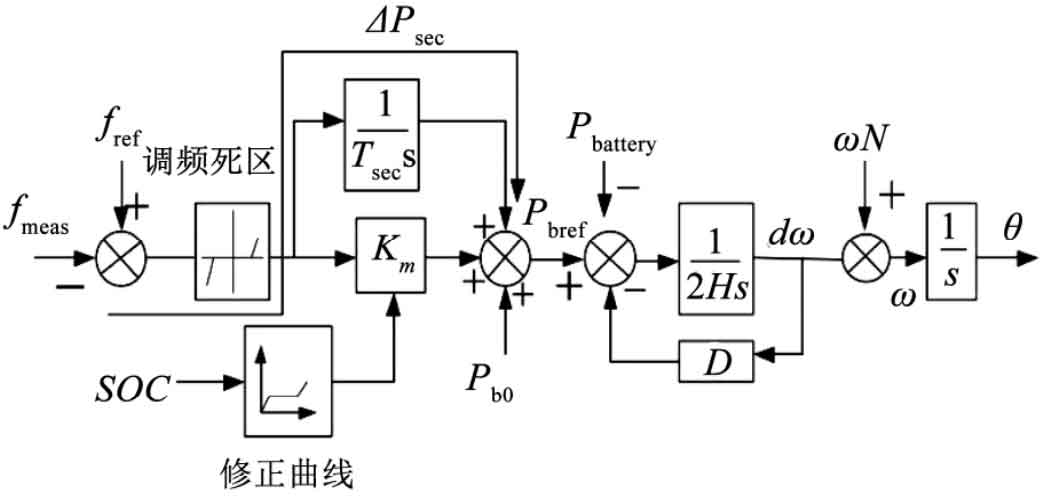
In the secondary frequency regulation controller, Ksec is activated and can be adjusted based on the accumulation of system frequency changes after the energy storage plant is put into use Δ Psec, and this adjustment process continues, ultimately leading to Δ F=0, enabling energy storage stations to provide higher quality secondary frequency regulation services. Secondary frequency modulation is an important process that involves secondary frequency modulation, descent, and damping. After the above steps, traditional units can quickly return to normal operation, readjust the rotor momentum to the optimal state that is not affected by external factors, and the system frequency will also return to the initial level, thus achieving effective coordination between energy storage power plants and users.
4. Conclusion
By studying the energy management strategy of battery energy storage power plants and its role in grid frequency regulation, the following conclusion can be drawn: using a third-order model based on synchronous machines can improve the transient voltage regulation ability of energy storage converters, making them possess the standard characteristics of synchronous machine excitation controllers and speed regulation controllers, greatly enhancing the frequency regulation and voltage regulation ability of energy storage power plants. Research has found that by setting the parameters of the energy storage system reasonably, it can meet the flexibility requirements, provide excellent damping and inertia characteristics, and become a powerful tool for large-scale new energy grid connection. Cooperate with traditional units to conduct frequency modulation, bringing a more stable frequency environment for the whole power grid.
